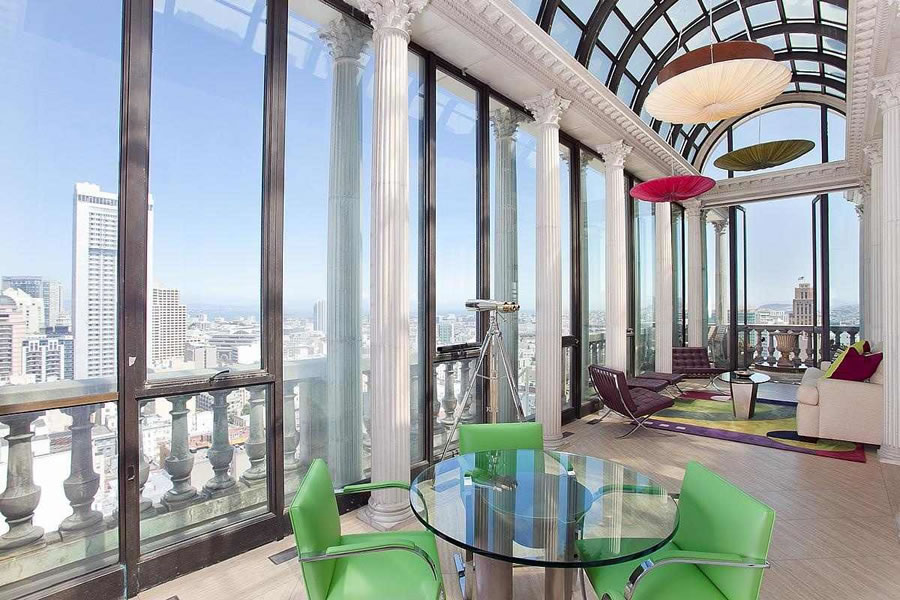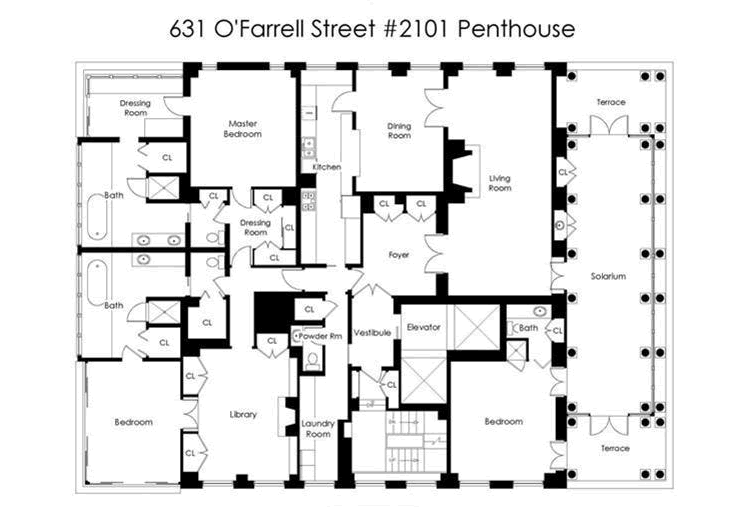Having been on and off the market for over five years, the full-floor penthouse unit atop the Art Deco Hamilton building at 631 O’Farrell Street, in the heart of the “Trendyloin,” is in contract to be sold.
Purchased for $2,500,000 in 2000 and listed for $4,500,000 in 2009, the 3,900-square-foot unit #2101 was remodeled and listed anew for $5,250,000 in 2013, re-listed for $4,250,000 in 2014, and then reduced to $3,950,000 this past July.
The barrel-vaulted glass solarium was added by the heiress who originally commissioned the penthouse, a merger of four proposed units, when the building was converted from a hotel to condominiums in 1962.
And while most of the units in the building don’t have a parking space, and there’s a wait list for the garage, the penthouse comes with parking for two cars. As a plugged-in reader and resident in the building reported back in 2009:
The [penthouse] does include leased parking in the basement – the current penthouse owner paid a significant amount of money to jump the line. That being said the parking list is turning over very fast right now – maybe a year to get to the top. This change could be attributed to the economy. But I do know of some residents who have gave up their cars to walk / use the car shares instead.






I’m trying to imagine how grand it looked without the wood painted over. Must’ve been nice.
I don’t think the Tenderloin can ever be all that trendy. I lived in multiple places the TL from 2002 to 2009. There’s too much low-income and SRO housing that is protected from development for there to be a tipping point level of gentrification.
Maybe after a few more suitcase stories the City will realize that the homeless issue is not only a housing issue but also a mental health issue. SROs + Care Not Cash do not solve the problem. A crazy person with a room is still a crazy person, and the city should not let them roam unchecked to the point that they own the street and sane people will stay away from some parts of their own city. /rant
If I thought that there was a realistic chance that the Supervisors would eliminate significant portions of the TL’s housing protections, I’d consider buying a building in the TL as a long-term investment. But, I don’t think that’s realistic in the foreseeable future.
To be fair to the City, the issue stems from the closing of public psychiatric facilities brought on by Reagan. That definitely didn’t help.
Serge and San FronziScheme are both correct; however, the compassion of the San Francisco taxpayers towards the problem is not affecting any positive changes regarding livability in the City. It is not working.
A “get tough” policy alone would do no better. Vexing. One thing it is not is a matter of civil liberties to live “free” on the streets. The only solution I see is to pay for their adequate care even if it has to be forced upon them.
A tale of 2 cities from your front door to your penthouse. I couldn’t handle the guilt and not enough cake to hand out
So, instead you live far aware from poverty and pretend it doesn’t exist?
less about poverty, more about mental health and drug addiction in the loin.
big difference not wanting it on my doorstep vs. pretending it doesn’t exist. I am a member of a program where i am involved almost daily with addicts. however, i dont want to live with active addicts on my doorstep. I could never afford this penthouse, but if i could, i sure wouldnt spend it at this location
Sure, this place has views, but of what?
For this price, you could have killer views from Telegraph Hill. From a smaller home, of course, but you would not be afraid to walk out your door.
That solarium looks like it would be hotter than Hades. And how did that glass hold up in the recent rains?
To quote Orson Welles, playing Harry Lime in The Third Man, sitting atop a ferris wheel looking down at the tiny folks below: “Victims? Don’t be melodramatic. Look down there. Tell me. Would you really feel any pity if one of those dots stopped moving forever? If I offered you twenty thousand pounds for every dot that stopped, would you really, old man, tell me to keep my money, or would you calculate how many of those dots you could afford to spare? Free of income tax, old man. Free of income tax – the only way you can save money nowadays…”
Absolute classic! Reminded I need to watch the movie again 🙂
In 2009 SF Human Services Agency published a detailed report assessing the needs of SRO residents (100+ page pdf at namelink). I don’t think the various responsible adults in city gov’t have many illusions about the problems, despite the occasional campaigning of greasy haired politicians seeking higher office.
FWIW, Tenderloin has about two-fifths of the SROs in SF (measured by buildings and units).
In his first year as President, Reagan halved the budget for public housing and Section 8. Those budgets never recovered fully and coming just after the Prop 13 cuts left SF without the money to deal with the people moved out of the horrible mental health facilities.
Perfect thread for another round of The Price Is Right, no?
This is one of my favorite properties in San Francisco. I would love love love to live here.
“Trendyloin”? More like Tendencyloin.
The solution is a long term psychiatric facility, similar to but much larger than Cordilleras in San Mateo County. The County of SF will never do that.
A practical alternative is slow gentrification, by allowing market rate development in the Tenderloin, not just at its edges. This could include transitioning SROs to cheap tourist hotels.
As things stand, San Francisco has a national reputation among the mentally ill and otherwise marginal as an exceedingly tolerant and generous place to live, combined with near perfect weather. An expansion of the program to pay for voluntary one-way tickets home would help.
The real question is whether there is any political will to do anything,
SROs are private, right? Even if they can’t kick people out, it seems like over time they’ll become more and more attractive to young tech workers and others (I understand that some of them already live in similar arrangements), and they’ll be able to raise their asking rents along with the rents in the rest of the city. At the same time, the influx of people with a less antagonistic relationship with the police might lead to more effective policing of quality-of-life offences inside and around the buildings, making them nicer places to live and accelerating the trend.
In other words, is it possible that the SROs themselves will become “gentrified”, while still remaining as SROs? If I understand my history, they were once working-class single peoples’ residences, and only became as seedy as they are today when central cities declined and everyone who was able to abandoned them for the suburbs. Seems like the demand is there for them to return to their former function.
The ‘problem’ is much bigger than San Francisco could ever handle. It is a national disgrace, one of many. And California is having trouble just tracking how $13 billion in Proposition 63 funds have been spent (namelink).
Given the long-established indifference and lack of funding, I don’t think any US city is an “exceedingly tolerant and generous place to live” for “the mentally ill and otherwise marginal.” To even suggest such a thing with the reality so plain before us shows how far some are from “tolerant and generous.”
FWIW, from their website: “Cordilleras Mental Health Rehabilitation Center (MHRC) houses two separate treatment programs for adults with chronic mental illness; a licensed 68-bed mental health rehabilitation center (MHRC) and a licensed 49-bed adult residential facility (ARF) called The Suites. Cordilleras primarily serves San Mateo County residents, 18 and older, with long histories of mental illness and multiple episodes of acute psychiatric hospitalization.”
“but much larger than”, yes, I’d say so.
It appears that Jake does not understand what I wrote, taking words far too literally.
San Francisco is much more tolerant than any major city: more tolerant of open drug deals, more tolerant of sleeping on the street, more tolerant allowing acute psychotic behavior to go untreated on the streets. It is much more generous with light use of psychiatric 72 hour holds, minimal criminal punishments for so-called victimless crimes.
It does all these things because local politicians have a bizarre idea that leaving people in need alone is kindness. It is not; it is cruel. As city government becomes more mainstream, there may be change, but we need more Farrells and fewer Camposes, more politicians who want to solve problems and fewer politicians concerned about the “rights” of people whose neuropsychiatric illnesses preclude them from using those rights.
Have you been to NY lately? In a whole week recently there were fewer sightings of homeless people than one can find in any ten minutes in downtown SF. A similar result exists in Paris and London, far bigger and greater cities. Perhaps SF should consult with its NYC counterparts on the problem.
This area is no worse than mid-Market or Hayes Valley, where we just had our first quadruple homicide of the year!
Ah NYC, where the “kindness” of stop-and-frisk was found unconstitutional by a federal judge, where the number of homeless is at an all time high, and there are more than 25 thousand homeless children. Just because the homeless don’t cross your path doesn’t mean they aren’t still around. During Michael Bloomberg’s term as mayor, the number of homeless in NYC soared more than 70% (namelink).
Isn’t Farrell the lawyer/bankster who violated campaign finance laws to win a very close election and has been directed to forfeit $190,000 to the city? Didn’t his campaign manager already pay a fine for violating campaign laws?
Perhaps if SF had a little less tolerance for those more concerned about “solutions” than being legal or respecting human rights we would be a greater city.
Does it have parking?